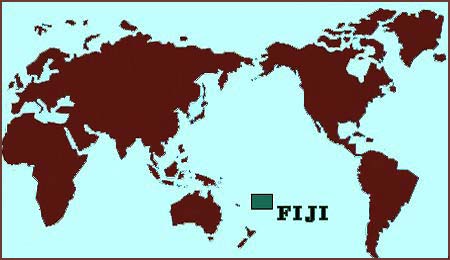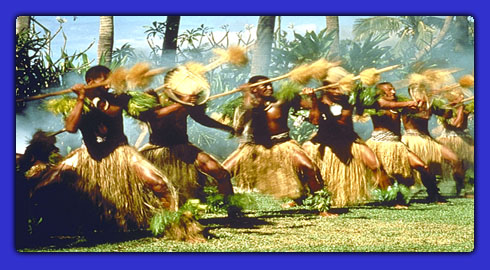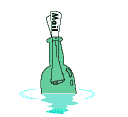From Auckland to Fiji and back to Auckland
We left Christchurch early in the morning arriving in Auckland with a short wait until we caught our 3 hour flight to Fiji. Fiji consists of some 332 islands scattered over about 3,000,000 square kilometers. Of the 332 islands, about 100 are inhabited. Fiji shares a time zone with New Zealand and since the Fiji Islands are just west of the international dateline, they're 22 hours ahead of Hawaii.

 The Fiji Islands are based on a submerged platform of ancient formation largely the product of volcanic action, sedimentary deposit, and formations of coral. The Fiji Islands enjoys a tropical South Sea maritime climate without great extremes of temperature. Almost half of The Fiji Islands' total area remains in forest, while dry grasslands are found in western areas of the large islands. Only 16 percent of The Fiji Islands' land mass is suitable for agriculture and are found mainly along the coastal plains, river deltas, and valleys. Coconut palms are common in coastal areas, and almost all tropical fruits and vegetables can be grown. Much of the shoreline is composed of reefs and rocks, while mangrove swamps are found on eastern coasts. There are few white-sand swimming beaches and, because of the encircling reef, little surf.
The Fiji Islands are based on a submerged platform of ancient formation largely the product of volcanic action, sedimentary deposit, and formations of coral. The Fiji Islands enjoys a tropical South Sea maritime climate without great extremes of temperature. Almost half of The Fiji Islands' total area remains in forest, while dry grasslands are found in western areas of the large islands. Only 16 percent of The Fiji Islands' land mass is suitable for agriculture and are found mainly along the coastal plains, river deltas, and valleys. Coconut palms are common in coastal areas, and almost all tropical fruits and vegetables can be grown. Much of the shoreline is composed of reefs and rocks, while mangrove swamps are found on eastern coasts. There are few white-sand swimming beaches and, because of the encircling reef, little surf.
Fiji's mixed racial background contributes to a rich cultural heritage. Many features of traditional Fijian life survive; they are most evident in the elaborate investiture, marriage, and other ceremonies for high-ranking chiefs. These ceremonies provide a focus for the practicing of traditional crafts, such as the manufacture of masi, or tapa cloth, made from the bark of the paper mulberry; mat weaving; wood carving; and canoe making. Drinking of yagona/yaqona,(kava), is a part not only of important ceremonies but also of everyday life.

With only 3 days in Fiji we quickly bartered our inexpensive 1 1/2 hour ride to Tubakula. We had an two story, "a frame" bungalo right on the beach. We watched the beautiful sunset and walked to the resort next door for dinner and saw a Fijian meke or song and dance performance in which legends, love stories, and historical events are told in song and gesture.
Ni Sa Bula ~ Greetings, we heard that everywhere we went, everyone was so friendly. Our stay in Fiji was very laid back and relaxing. Our first morning we walked to breakfast and on the way back walked up to an Eco-park. We walked through the lush rainforest trails and saw various birds and foliage as we wound up and around the river. One of the more unusual creatures found in Fiji is the banded iguana, a lizard that lives in trees and can grow up to 70 centimeters long (two-thirds of which is tail). The iguanas are emerald green and change color to control their internal temperature, becoming darker when in the direct sun.


 The rest of the day we spent at the beach sunning and walking around the reef in our water shoes. At low tide the reef looked like all these dark semi-crushed mounds. The waves were crashing really far out in the water, visually it was so different. We saw these long black snake looking creatures with suction cups and a mouth like an octopus, starfish, electric blue fish and stripped black and white fish. Mid-afternoon we swam in the hostels pool and just before dinner we sat on our front porch as Michael practiced how to open a coconut on our metal porch chair,a trick he learned from one of the hostels employees.
The rest of the day we spent at the beach sunning and walking around the reef in our water shoes. At low tide the reef looked like all these dark semi-crushed mounds. The waves were crashing really far out in the water, visually it was so different. We saw these long black snake looking creatures with suction cups and a mouth like an octopus, starfish, electric blue fish and stripped black and white fish. Mid-afternoon we swam in the hostels pool and just before dinner we sat on our front porch as Michael practiced how to open a coconut on our metal porch chair,a trick he learned from one of the hostels employees.
Our third day in Fiji we toured west of Tubakula with Johnny, our private "tour guide", past villages, visited a handicraft shop and then headed back to Nadi. On the way we saw the Sigatoka
Sand Dunes.
For lunch we had one of the most delicious Indian meals in the busy city of Nadi before heading out to the Saweni Resort. Once we had settled in we spent the day relaxing on the beach, by the pool and on the grounds and this was where Michael was really able to practice and master his coconut opening technique and climbing coconut trees. For dinner we walked out of the compound to the little store and restaurant where we enjoyed yet another homecooked Indian meal. Our stay in Fiji was short, the following morning we flew back to Auckland for the day before heading back to the US.
If you have any suggestions or questions email me:


 The Fiji Islands are based on a submerged platform of ancient formation largely the product of volcanic action, sedimentary deposit, and formations of coral. The Fiji Islands enjoys a tropical South Sea maritime climate without great extremes of temperature. Almost half of The Fiji Islands' total area remains in forest, while dry grasslands are found in western areas of the large islands. Only 16 percent of The Fiji Islands' land mass is suitable for agriculture and are found mainly along the coastal plains, river deltas, and valleys. Coconut palms are common in coastal areas, and almost all tropical fruits and vegetables can be grown. Much of the shoreline is composed of reefs and rocks, while mangrove swamps are found on eastern coasts. There are few white-sand swimming beaches and, because of the encircling reef, little surf.
The Fiji Islands are based on a submerged platform of ancient formation largely the product of volcanic action, sedimentary deposit, and formations of coral. The Fiji Islands enjoys a tropical South Sea maritime climate without great extremes of temperature. Almost half of The Fiji Islands' total area remains in forest, while dry grasslands are found in western areas of the large islands. Only 16 percent of The Fiji Islands' land mass is suitable for agriculture and are found mainly along the coastal plains, river deltas, and valleys. Coconut palms are common in coastal areas, and almost all tropical fruits and vegetables can be grown. Much of the shoreline is composed of reefs and rocks, while mangrove swamps are found on eastern coasts. There are few white-sand swimming beaches and, because of the encircling reef, little surf.


